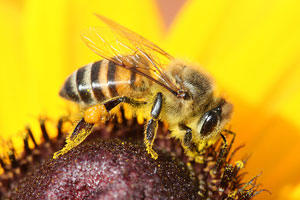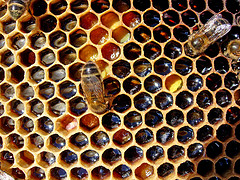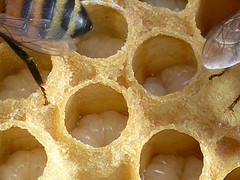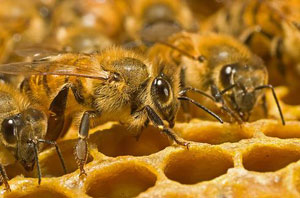 - During the period of its growth a single larva is visited by worker bees some 10,000 times. Bees know how many days old the larvae are, and with what each one should be fed.
- During the period of its growth a single larva is visited by worker bees some 10,000 times. Bees know how many days old the larvae are, and with what each one should be fed.- On the seventh day the larva stops eating, and the nursing bees entirely stop up the mouth of cell containing the larva with a lightly domed cover made of wax. During this time, the larva locks itself inside the chamber by weaving a cocoon around itself. One feature of the cocoon is that the protein called "fibroin" it contains is a powerful bactericide and prevents infection. The cocoons the larvae weave thus protect them against germs.
- Until the third day, the larvae are fed with a substance known as royal jelly, and from the third day on with another substance called bee bread. Only those larvae that will turn into queens are fed on royal jelly for the whole six days. It is this different feeding regime that allows them to develop further and turn into queens.
- When the worker bees are 12 days old they become capable of producing wax and immediately emerge and start building honey combs.
- As the worker bees clean the hive they remove all waste products and foreign bodies and deposit them several meters away from the hive.
- If a foreign object inside the hive is too large to carry, then they cover it in a substance known as “propolis." Bees manufacture propolis by adding saliva to the sticky resin obtained from the buds of certain trees. The important feature of propolis, also known as bee glue, is that it prevents any bacterial growth. By covering with propolis insects they have killed inside the hive but that are too large to be disposed of, bees engage in a kind of mummification process.
 - Bees also fill in cracks and holes in the hive with propolis. They increase wax resistance by adding propolis to prevent the combs melting in some volcanic areas with very high temperatures.
- Bees also fill in cracks and holes in the hive with propolis. They increase wax resistance by adding propolis to prevent the combs melting in some volcanic areas with very high temperatures.- Bees have slight concavities on the outside of their hind legs. This part of their bodies literally resembles a spoon for carrying pollen. This part of their bodies is known as the "pollen basket." In addition, their legs are covered in long hairs. These features mean that bees are able to carry more pollen than other insects.
- In order to completely fill their honey stomachs, which have a capacity of around 50 mm3, with nectar, honeybees have to visit between 100 and 150 flowers.
- The forager bee returning loaded with nectar does not waste time placing it into the cells. It instead transfers the nectar by mouth to bees charged with that job. It leaves as much nectar as it needs for energy in its stomach and flies back to the source of the food. The bee the nectar is transferred to will either store it or hand it on to other workers. This process depends on the food requirements of the bees in the hive at the time.
- When any damage occurs in the hive as the result of an attack or fire, those adults not engaged in producing wax immediately start doing so in order to repair the damage.
 - When the stock of honey is insufficient, more bees may go out to look for nectar, or if the hive needs to be cooled down urgently other bees will stop what they are doing and begin that job instead. When the hive is subjected to a major attack, most of the bees will join in the defense, with hundreds gathering at the entrance to the hive to repel invaders.
- When the stock of honey is insufficient, more bees may go out to look for nectar, or if the hive needs to be cooled down urgently other bees will stop what they are doing and begin that job instead. When the hive is subjected to a major attack, most of the bees will join in the defense, with hundreds gathering at the entrance to the hive to repel invaders.- The temperature of the hive is maintained at 34.5°C-35.5°C all year round. In the early morning, when it is cold, the workers mass around the hive and warm the eggs with their body heat. As the day goes by and the air begins to warm up, the mass established around the hive by the workers gradually disperses. If the temperature continues to rise then some of the workers begin beating their wings like fans in order to bring it back down. When the temperature of the hive rises very high, the bees collecting food bring drops of water from sources nearby, instead of pollen or nectar, and sprinkle these over the incubation cells.
- When the hive temperature falls, the bees first cling tightly to one another in a large mass. The thickness of this mass varies from 2.5 cm to 7.5 cm, depending on the temperature, and it covers the combs like a shell. The bees raise the temperature by constantly moving. Using this technique, bees can maintain the temperature of the hive at around 35°C even when the outside temperature falls to as low as -30°C.
- Throughout the larval period the future queen is given 10 mg of royal jelly, compared to only 3 mg for other bees.
- Although, like the queen, the worker bees are female, they are unable to produce eggs. In addition, contrary to the worker bees, the queen’s mandible lacks the necessary structure for making wax cells. The queen bee also lacks the hard hairs that fringe the pollen basket. Furthermore, although the queen be
 es emerge from the same eggs, because of their different nutrition they live for 4-5 years, compared to the workers’ 5-6 weeks.
es emerge from the same eggs, because of their different nutrition they live for 4-5 years, compared to the workers’ 5-6 weeks.- It is the worker bees that determine the gender of the egg. It is they who direct the queen. That is because whatever kind of cell the workers have prepared, the queen lays an egg accordingly. If the queen encounters a standard female cell measuring 5.2 mm, then she carries out fertilization and deposits an egg that will hatch into a female bee. If she encounters cells that are 1 mm larger, then she deposits eggs without fertilizing them, which will eventually hatch into male bees. To put it another way, the queen will lay as many drone eggs as the male bee chambers built by the workers.
- When conditions suddenly change and the colony faces the danger of being left without a queen, the worker bees immediately start feeding a few of the existing larvae with royal jelly. They also tear down the walls of the cell and expand it.
- All the information that bees need in order to be able to locate a food source, its distance from the hive, direction and wealth, is concealed in a dance they perform. Bees calculate that the Sun moves 1 degree every 4 minutes. In one experiment, 155 out of 174 worker bees watching a dance were observed to locate the source of food within 5 minutes.
 - If the food source discovered is unproductive the bees still dance. The only difference is that they dance lethargically and for only a short time. The bees that collect around the dancer soon disperse.
- If the food source discovered is unproductive the bees still dance. The only difference is that they dance lethargically and for only a short time. The bees that collect around the dancer soon disperse.- Bees mark flowers by depositing a special scent on them. In this way, as soon as bees land on a flower that has previously been used up by other bees they realize this and fly off at once, thus avoid wasting time and energy.
- If a new queen hatches while the old one is still in the hive, this is a threat that could damage the equilibrium in it. For that reason, they lock potential queens that complete their development and try to emerge by tearing open their pupae with stronger chamber covers.
- Bees consume around 22 kg of honey to produce 1 kg of wax. They take beads of wax from their secretion glands in approximately the size of a pinhead.


